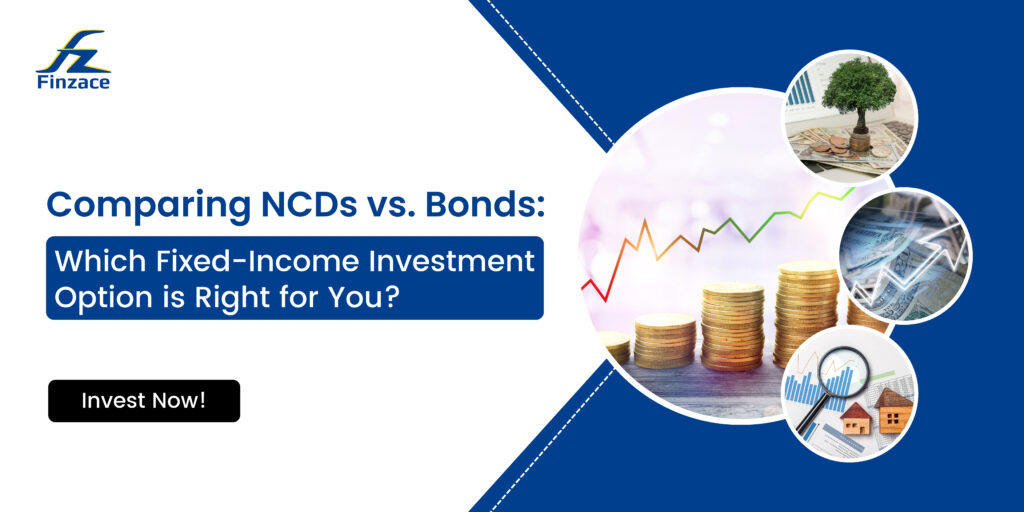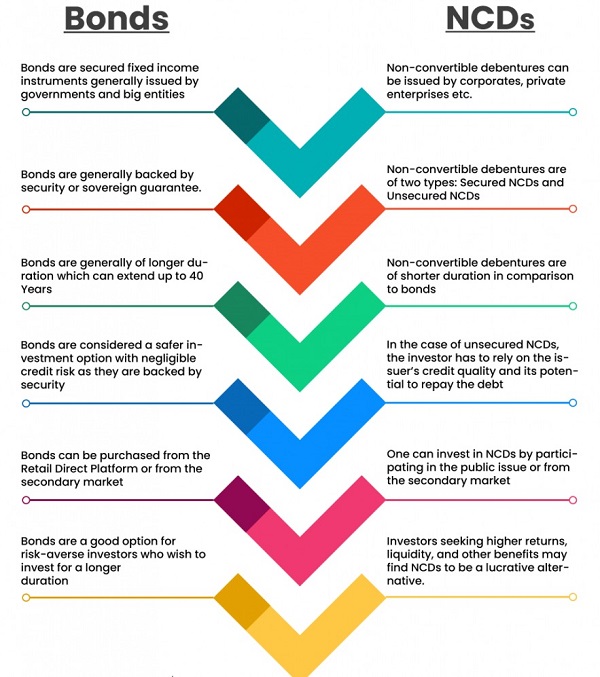Bonds vs Non-Convertible Debentures: The Ultimate 2025 Comparison Guide for Smart Investors

Fixed-income securities like bonds and Non-Convertible Debentures (NCDs) are often seen as safe havens for conservative investors. With growing interest in stable returns amidst global volatility, understanding these instruments is key. In 2024 alone, investments in fixed-income securities grew by 18.7%, underscoring the importance of knowing the difference between bonds and NCDs.
This guide will give you a comprehensive comparison of bonds and NCDs, helping you make smart, informed decisions for your 2025 investment portfolio.
What Are Bonds?
Bonds are debt instruments issued by governments, corporations, or municipalities. When you buy a bond, you’re essentially lending money to the issuer in exchange for periodic interest payments (coupons) and the return of your principal at maturity.
Key Features of Bonds:
- Security Backing: Bonds can be backed by assets, government guarantees, or simply the issuer’s financial stability.
- Interest Payments: Typically paid semi-annually or annually.
- Maturity: Ranges from 1 year to 30+ years, with set repayment schedules.
Types of Bonds:
- Government Bonds: Issued by sovereign nations (e.g., U.S. Treasury Bonds, Indian Government Securities). They are considered low-risk and offer relatively lower yields (3.8%-4.5% in 2025).
- Corporate Bonds: Issued by companies and offer higher returns. They come in two categories—investment-grade and high-yield bonds (5.2%-8.7% in 2025).
- Municipal Bonds: Issued by local governments, often with tax benefits (4.0%-5.5% in 2025).
What Are Non-Convertible Debentures (NCDs)?
NCDs are debt instruments issued by corporations, typically for medium to long-term funding. Unlike convertible debentures, NCDs cannot be converted into equity shares.
Key Features of NCDs:
- Security: NCDs can be secured (backed by assets) or unsecured.
- Interest: They usually offer higher interest rates than bonds, as compensation for a higher risk.
- Maturity: Typically 3-10 years, with some flexibility.
Types of NCDs:
- Secured NCDs: Backed by specific assets. They are lower-risk but offer moderate yields (7.5%-9.0% in 2025).
- Unsecured NCDs: Not backed by collateral, hence riskier but offer higher returns (9.0%-12.0% in 2025).
- Market-Linked NCDs: Their returns are tied to market performance, offering higher yields (8.0%-14.0%) with greater volatility.
Comparing NCDs and Bonds:

Performance Comparison: Historical Returns
Government Bonds Average Annual Returns (2015-2025):
- 2015-2020: 5.8%
- 2020-2025: 4.6%
Corporate Bonds Average Annual Returns (2015-2025):
- 2015-2020: 7.3%
- 2020-2025: 6.9%
NCDs Average Annual Returns (2015-2025):
- Secured NCDs: 8.7% (2020-2025)
- Unsecured NCDs: 10.8% (2020-2025)
While NCDs generally offer higher returns than bonds, they come with higher volatility and risk. Therefore, investors must assess their risk tolerance before investing.
Risk Assessment: Which is Safer?
Credit Risk:
- Government Bonds: Extremely low default risk (especially for developed economies).
- Corporate Bonds: Varies depending on the issuer’s credit rating.
- NCDs: Higher risk for unsecured NCDs; secured NCDs are relatively safer.
Interest Rate Risk:
Both bonds and NCDs are affected by changes in interest rates. Longer-term instruments, such as 30-year bonds, are more sensitive to rate changes, whereas shorter-term NCDs (3-5 years) typically experience less price volatility.
Liquidity Risk:
- Most Liquid: Government bonds and AAA-rated corporate bonds.
- Moderately Liquid: Secured NCDs from top-rated companies.
- Less Liquid: Unsecured NCDs, especially from lower-rated issuers.
Investment Strategy: How to Choose Between Bonds and NCDs
Conservative Investors:
- Focus: Capital preservation and steady income.
- Allocation: 70%-80% government bonds, 20%-30% high-grade corporate bonds.
- Consider NCDs: Only secured NCDs from AAA-rated issuers.
Moderate Risk Investors:
- Focus: Balance between income and growth.
- Allocation: 40%-50% government bonds, 30%-40% corporate bonds, 10%-20% secured NCDs.
- Consider NCDs: Yes, but stick to secured NCDs from A+ rated companies and above.
Aggressive Investors:
- Focus: Maximizing returns with higher risk.
- Allocation: 20%-30% government bonds, 30%-40% corporate bonds, 30%-40% NCDs (mix of secured and unsecured).
- Consider NCDs: Yes, including unsecured NCDs for higher yield.
Recommendations
- For Conservative Investors: “Stick with government bonds and AAA-rated corporate bonds. Keep NCD exposure low to minimize risk.” — Vikram Narayan, Chief Investment Officer, SBI Mutual Fund.
- For Income Seekers: “Consider a barbell strategy combining short-duration government bonds and longer-term NCDs for higher returns.” — Anjali Sharma, Fixed Income Strategist, DSP BlackRock.
- For Balanced Portfolios: “Diversify across bonds and NCDs. A 40-30-30 allocation between government bonds, corporate bonds, and NCDs strikes a good balance.” — Manish Chokhani, Director, Enam Holdings.
Taxation Aspects of Bonds vs NCDs
Bonds:
- Interest: Taxable based on your income tax slab.
- Capital Gains: Long-term (holding >12 months) taxed at 10% without indexation. Short-term capital gains are taxed at the slab rate.
- Tax-Free Bonds: A good option for those in higher tax brackets, offering tax-exempt interest.
NCDs:
- Interest: Taxable as per your income tax slab.
- Capital Gains: Long-term gains (holding >12 months) taxed at 10% without indexation. Short-term gains are taxed at the slab rate.
- TDS: 10% on interest payments (if exceeding ₹10,000 annually).
FAQs About Bonds and NCDs
- Q: What’s the minimum investment required for bonds and NCDs?
- A: Government bonds can be bought for as little as ₹10,000, while corporate bonds and NCDs typically require a minimum of ₹10,000-₹25,000.
- A: Government bonds can be bought for as little as ₹10,000, while corporate bonds and NCDs typically require a minimum of ₹10,000-₹25,000.
- Q: Can I exit before maturity?
- A: Yes, both bonds and listed NCDs can be sold in the secondary market, though liquidity may vary.
- A: Yes, both bonds and listed NCDs can be sold in the secondary market, though liquidity may vary.
- Q: Are all government bonds equally safe?
- A: No, developed nation government bonds are extremely safe, but emerging market bonds can carry higher risks.
- A: No, developed nation government bonds are extremely safe, but emerging market bonds can carry higher risks.
Conclusion: Making the Right Choice for Your Portfolio
Both bonds and NCDs can play a vital role in a diversified investment strategy, offering stability and predictable returns. The key is to align your investment choice with your financial goals, risk tolerance, and time horizon.
- Choose Bonds: If you prioritize safety, liquidity, and tax advantages (especially government bonds).
- Choose NCDs: If you’re seeking higher returns and can tolerate a bit more risk, particularly from high-quality, secured NCDs.
Incorporating a mix of both—government bonds for stability and NCDs for enhanced yield—can create a robust fixed-income portfolio that supports your financial goals in 2025 and beyond.
Start Exploring Today: If you’re ready to explore investment options in bonds or NCDs, visit Finzace for the latest updates.


